Financial Accounting Analysis of Rolls-Royce
VerifiedAdded on 2023/06/12
|7
|1260
|164
AI Summary
This article provides a financial accounting analysis of Rolls-Royce, including its major operations, strategies, objectives, and performance measurement. It also includes a year-wise and company-wise comparison to measure the performance.
Contribute Materials
Your contribution can guide someone’s learning journey. Share your
documents today.
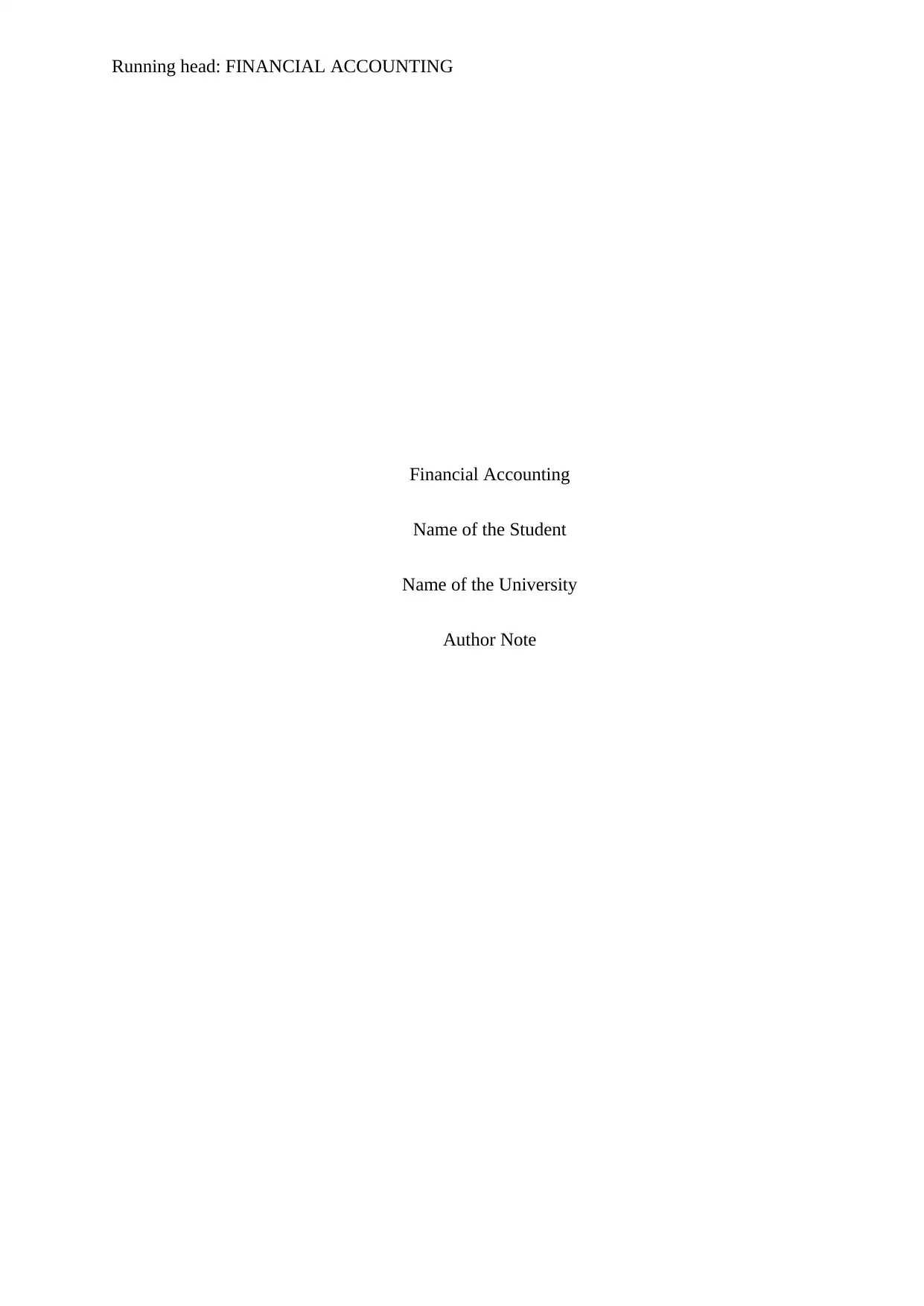
Running head: FINANCIAL ACCOUNTING
Financial Accounting
Name of the Student
Name of the University
Author Note
Financial Accounting
Name of the Student
Name of the University
Author Note
Secure Best Marks with AI Grader
Need help grading? Try our AI Grader for instant feedback on your assignments.

1FINANCIAL ACCOUNTING
Table of Contents
Brief overview of the company..................................................................................................2
Major operations of the company..............................................................................................2
The strategy and objectives of the company..............................................................................2
Performance measurement.........................................................................................................4
The year wise and company wise comparison to measure the performance.............................4
Performance and operation analysis and current position of the company................................4
References..................................................................................................................................6
Table of Contents
Brief overview of the company..................................................................................................2
Major operations of the company..............................................................................................2
The strategy and objectives of the company..............................................................................2
Performance measurement.........................................................................................................4
The year wise and company wise comparison to measure the performance.............................4
Performance and operation analysis and current position of the company................................4
References..................................................................................................................................6

2FINANCIAL ACCOUNTING
Brief overview of the company
The chosen company for the analysis has been taken Rolls-Royce which is a
multinational public company is Britain. The company was established in theyear1904 and
deals with aircraft manufacturing. The world’s second-largest maker of aircraft engines
Rolls-Royce has major businesses in the energy sectors and marine propulsion. All of its
shares are tradable on other markets and London Stock Exchange. The headquarters are in
London and is constituent of FTSE 100 index. Aerospace business Rolls-Royce makes
military gas turbine engines for military, commercial, civil, and corporate aircraft clients
globally.
Major operations of the company
The Rolls-Royce pioneers utilizes cutting edge technology for delivering the cleanest,
safest and the most competitive to meet the needs of the people. Aerospace business of Rolls-
Royce makes commercial and military gas turbine engines for military, civil, and corporate
aircraft customers globally and holds 90% market share (King & Fitzgerald, 2016). The
company also engages in regional and corporate jets, turboprop aircraft and helicopters,
and manufacturing. Rolls-Royce also installs and constructs power generation systems this
can be said to be the most interesting operating of the company. Another interesting
component of the company is that its core gas turbine technology has created one of the
broadest product ranges of aero-engines in the world, with 50,000 engines in service with 500
airlines, 2,400 corporate and utility operators and more than 100 armed forces, powering
both fixed- and rotary-wing aircraft. The subsidiary company of Rolls Royce manufactures
and tests nuclear reactors for making submarines named Rolls-Royce Marine Power
Operations Ltd.
Brief overview of the company
The chosen company for the analysis has been taken Rolls-Royce which is a
multinational public company is Britain. The company was established in theyear1904 and
deals with aircraft manufacturing. The world’s second-largest maker of aircraft engines
Rolls-Royce has major businesses in the energy sectors and marine propulsion. All of its
shares are tradable on other markets and London Stock Exchange. The headquarters are in
London and is constituent of FTSE 100 index. Aerospace business Rolls-Royce makes
military gas turbine engines for military, commercial, civil, and corporate aircraft clients
globally.
Major operations of the company
The Rolls-Royce pioneers utilizes cutting edge technology for delivering the cleanest,
safest and the most competitive to meet the needs of the people. Aerospace business of Rolls-
Royce makes commercial and military gas turbine engines for military, civil, and corporate
aircraft customers globally and holds 90% market share (King & Fitzgerald, 2016). The
company also engages in regional and corporate jets, turboprop aircraft and helicopters,
and manufacturing. Rolls-Royce also installs and constructs power generation systems this
can be said to be the most interesting operating of the company. Another interesting
component of the company is that its core gas turbine technology has created one of the
broadest product ranges of aero-engines in the world, with 50,000 engines in service with 500
airlines, 2,400 corporate and utility operators and more than 100 armed forces, powering
both fixed- and rotary-wing aircraft. The subsidiary company of Rolls Royce manufactures
and tests nuclear reactors for making submarines named Rolls-Royce Marine Power
Operations Ltd.
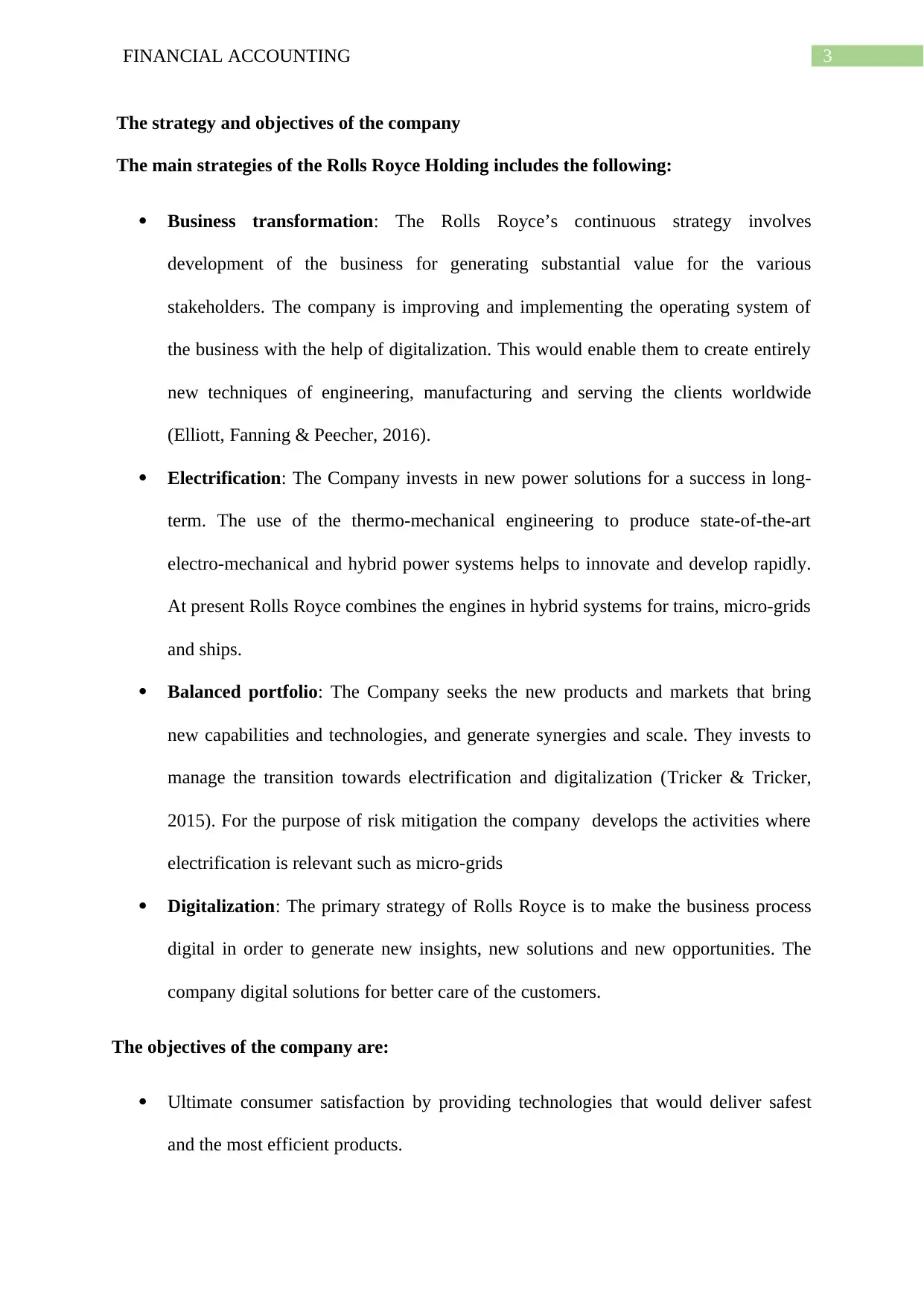
3FINANCIAL ACCOUNTING
The strategy and objectives of the company
The main strategies of the Rolls Royce Holding includes the following:
Business transformation: The Rolls Royce’s continuous strategy involves
development of the business for generating substantial value for the various
stakeholders. The company is improving and implementing the operating system of
the business with the help of digitalization. This would enable them to create entirely
new techniques of engineering, manufacturing and serving the clients worldwide
(Elliott, Fanning & Peecher, 2016).
Electrification: The Company invests in new power solutions for a success in long-
term. The use of the thermo-mechanical engineering to produce state-of-the-art
electro-mechanical and hybrid power systems helps to innovate and develop rapidly.
At present Rolls Royce combines the engines in hybrid systems for trains, micro-grids
and ships.
Balanced portfolio: The Company seeks the new products and markets that bring
new capabilities and technologies, and generate synergies and scale. They invests to
manage the transition towards electrification and digitalization (Tricker & Tricker,
2015). For the purpose of risk mitigation the company develops the activities where
electrification is relevant such as micro-grids
Digitalization: The primary strategy of Rolls Royce is to make the business process
digital in order to generate new insights, new solutions and new opportunities. The
company digital solutions for better care of the customers.
The objectives of the company are:
Ultimate consumer satisfaction by providing technologies that would deliver safest
and the most efficient products.
The strategy and objectives of the company
The main strategies of the Rolls Royce Holding includes the following:
Business transformation: The Rolls Royce’s continuous strategy involves
development of the business for generating substantial value for the various
stakeholders. The company is improving and implementing the operating system of
the business with the help of digitalization. This would enable them to create entirely
new techniques of engineering, manufacturing and serving the clients worldwide
(Elliott, Fanning & Peecher, 2016).
Electrification: The Company invests in new power solutions for a success in long-
term. The use of the thermo-mechanical engineering to produce state-of-the-art
electro-mechanical and hybrid power systems helps to innovate and develop rapidly.
At present Rolls Royce combines the engines in hybrid systems for trains, micro-grids
and ships.
Balanced portfolio: The Company seeks the new products and markets that bring
new capabilities and technologies, and generate synergies and scale. They invests to
manage the transition towards electrification and digitalization (Tricker & Tricker,
2015). For the purpose of risk mitigation the company develops the activities where
electrification is relevant such as micro-grids
Digitalization: The primary strategy of Rolls Royce is to make the business process
digital in order to generate new insights, new solutions and new opportunities. The
company digital solutions for better care of the customers.
The objectives of the company are:
Ultimate consumer satisfaction by providing technologies that would deliver safest
and the most efficient products.
Secure Best Marks with AI Grader
Need help grading? Try our AI Grader for instant feedback on your assignments.
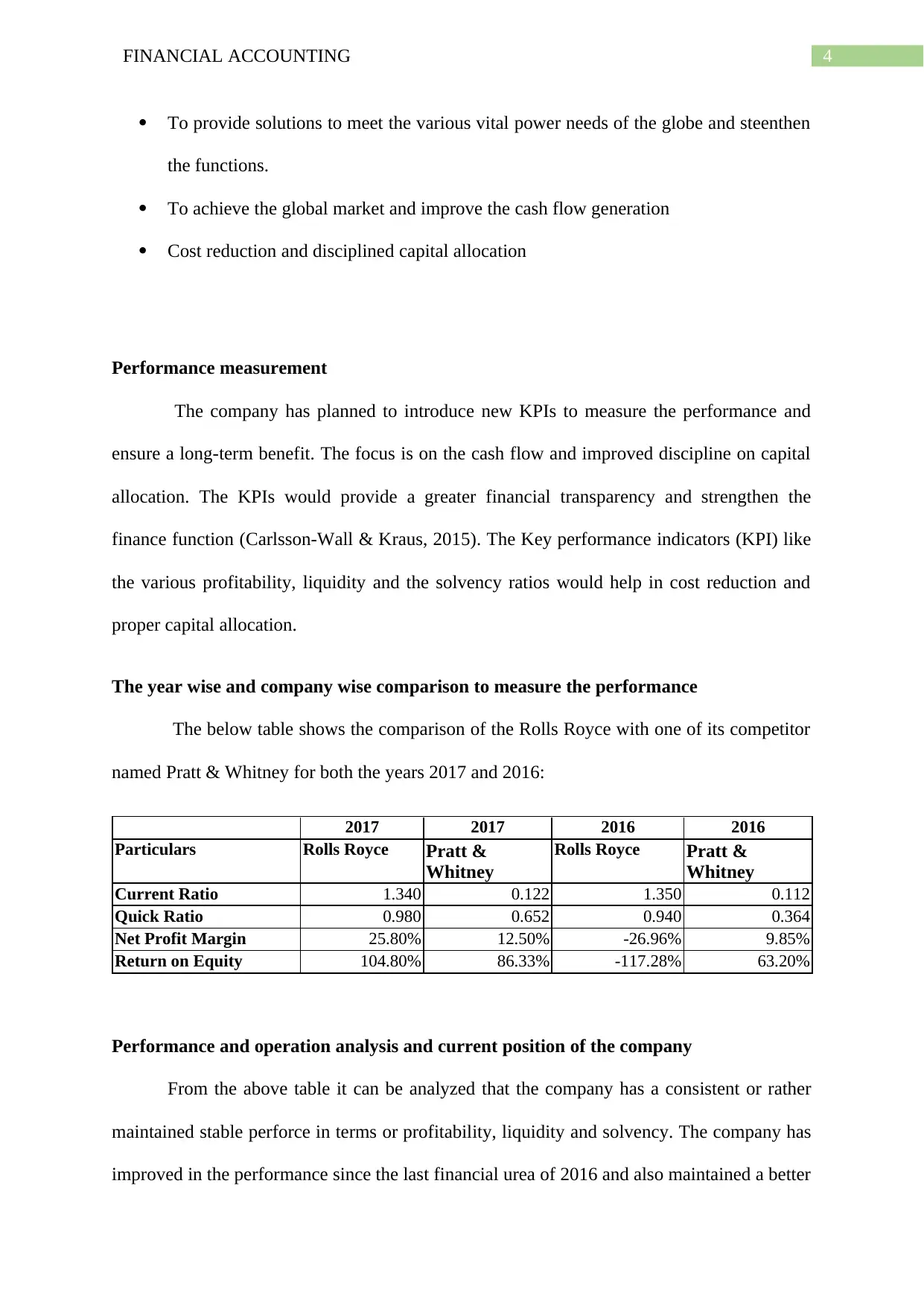
4FINANCIAL ACCOUNTING
To provide solutions to meet the various vital power needs of the globe and steenthen
the functions.
To achieve the global market and improve the cash flow generation
Cost reduction and disciplined capital allocation
Performance measurement
The company has planned to introduce new KPIs to measure the performance and
ensure a long-term benefit. The focus is on the cash flow and improved discipline on capital
allocation. The KPIs would provide a greater financial transparency and strengthen the
finance function (Carlsson-Wall & Kraus, 2015). The Key performance indicators (KPI) like
the various profitability, liquidity and the solvency ratios would help in cost reduction and
proper capital allocation.
The year wise and company wise comparison to measure the performance
The below table shows the comparison of the Rolls Royce with one of its competitor
named Pratt & Whitney for both the years 2017 and 2016:
2017 2017 2016 2016
Particulars Rolls Royce Pratt &
Whitney
Rolls Royce Pratt &
Whitney
Current Ratio 1.340 0.122 1.350 0.112
Quick Ratio 0.980 0.652 0.940 0.364
Net Profit Margin 25.80% 12.50% -26.96% 9.85%
Return on Equity 104.80% 86.33% -117.28% 63.20%
Performance and operation analysis and current position of the company
From the above table it can be analyzed that the company has a consistent or rather
maintained stable perforce in terms or profitability, liquidity and solvency. The company has
improved in the performance since the last financial urea of 2016 and also maintained a better
To provide solutions to meet the various vital power needs of the globe and steenthen
the functions.
To achieve the global market and improve the cash flow generation
Cost reduction and disciplined capital allocation
Performance measurement
The company has planned to introduce new KPIs to measure the performance and
ensure a long-term benefit. The focus is on the cash flow and improved discipline on capital
allocation. The KPIs would provide a greater financial transparency and strengthen the
finance function (Carlsson-Wall & Kraus, 2015). The Key performance indicators (KPI) like
the various profitability, liquidity and the solvency ratios would help in cost reduction and
proper capital allocation.
The year wise and company wise comparison to measure the performance
The below table shows the comparison of the Rolls Royce with one of its competitor
named Pratt & Whitney for both the years 2017 and 2016:
2017 2017 2016 2016
Particulars Rolls Royce Pratt &
Whitney
Rolls Royce Pratt &
Whitney
Current Ratio 1.340 0.122 1.350 0.112
Quick Ratio 0.980 0.652 0.940 0.364
Net Profit Margin 25.80% 12.50% -26.96% 9.85%
Return on Equity 104.80% 86.33% -117.28% 63.20%
Performance and operation analysis and current position of the company
From the above table it can be analyzed that the company has a consistent or rather
maintained stable perforce in terms or profitability, liquidity and solvency. The company has
improved in the performance since the last financial urea of 2016 and also maintained a better
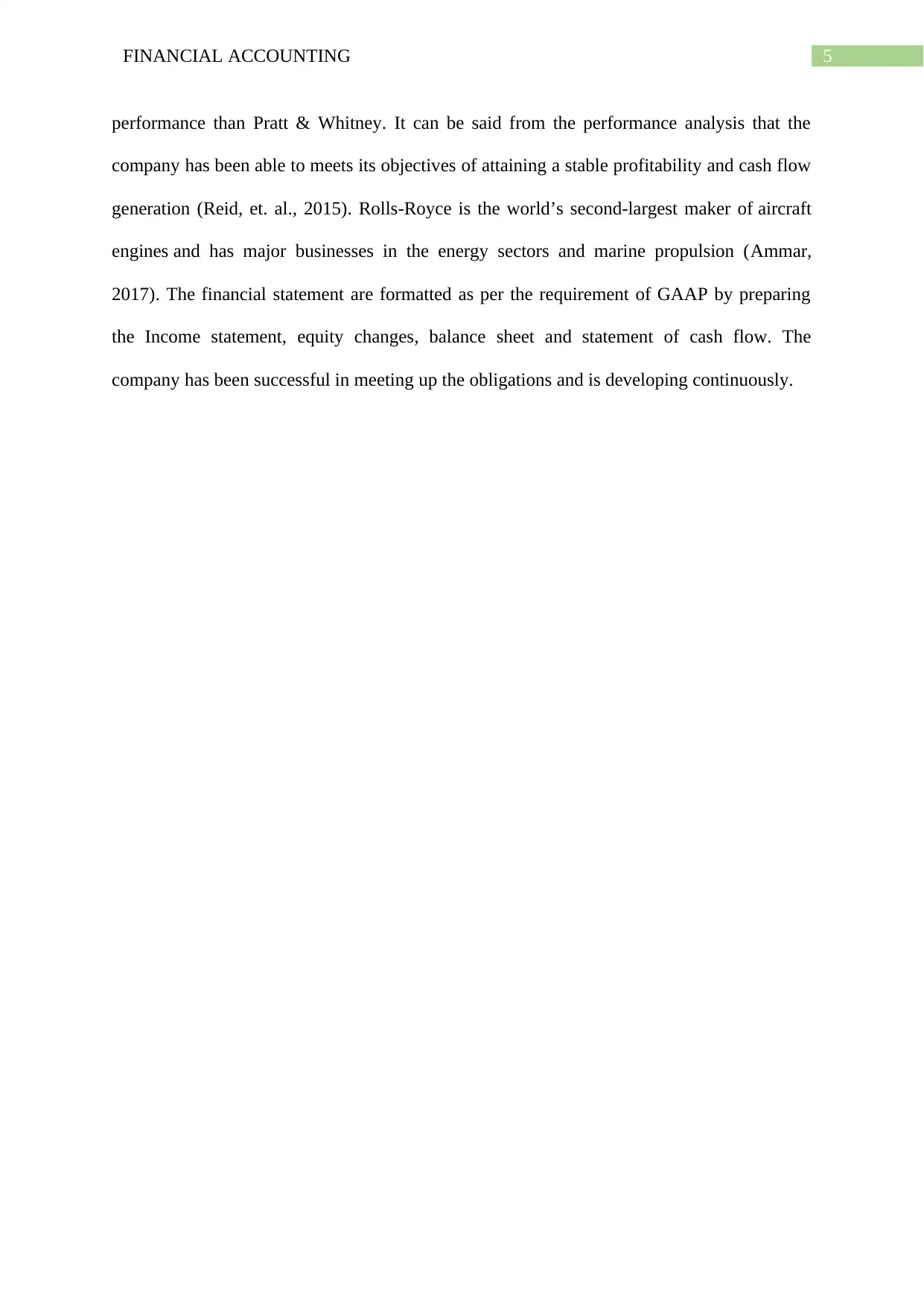
5FINANCIAL ACCOUNTING
performance than Pratt & Whitney. It can be said from the performance analysis that the
company has been able to meets its objectives of attaining a stable profitability and cash flow
generation (Reid, et. al., 2015). Rolls-Royce is the world’s second-largest maker of aircraft
engines and has major businesses in the energy sectors and marine propulsion (Ammar,
2017). The financial statement are formatted as per the requirement of GAAP by preparing
the Income statement, equity changes, balance sheet and statement of cash flow. The
company has been successful in meeting up the obligations and is developing continuously.
performance than Pratt & Whitney. It can be said from the performance analysis that the
company has been able to meets its objectives of attaining a stable profitability and cash flow
generation (Reid, et. al., 2015). Rolls-Royce is the world’s second-largest maker of aircraft
engines and has major businesses in the energy sectors and marine propulsion (Ammar,
2017). The financial statement are formatted as per the requirement of GAAP by preparing
the Income statement, equity changes, balance sheet and statement of cash flow. The
company has been successful in meeting up the obligations and is developing continuously.
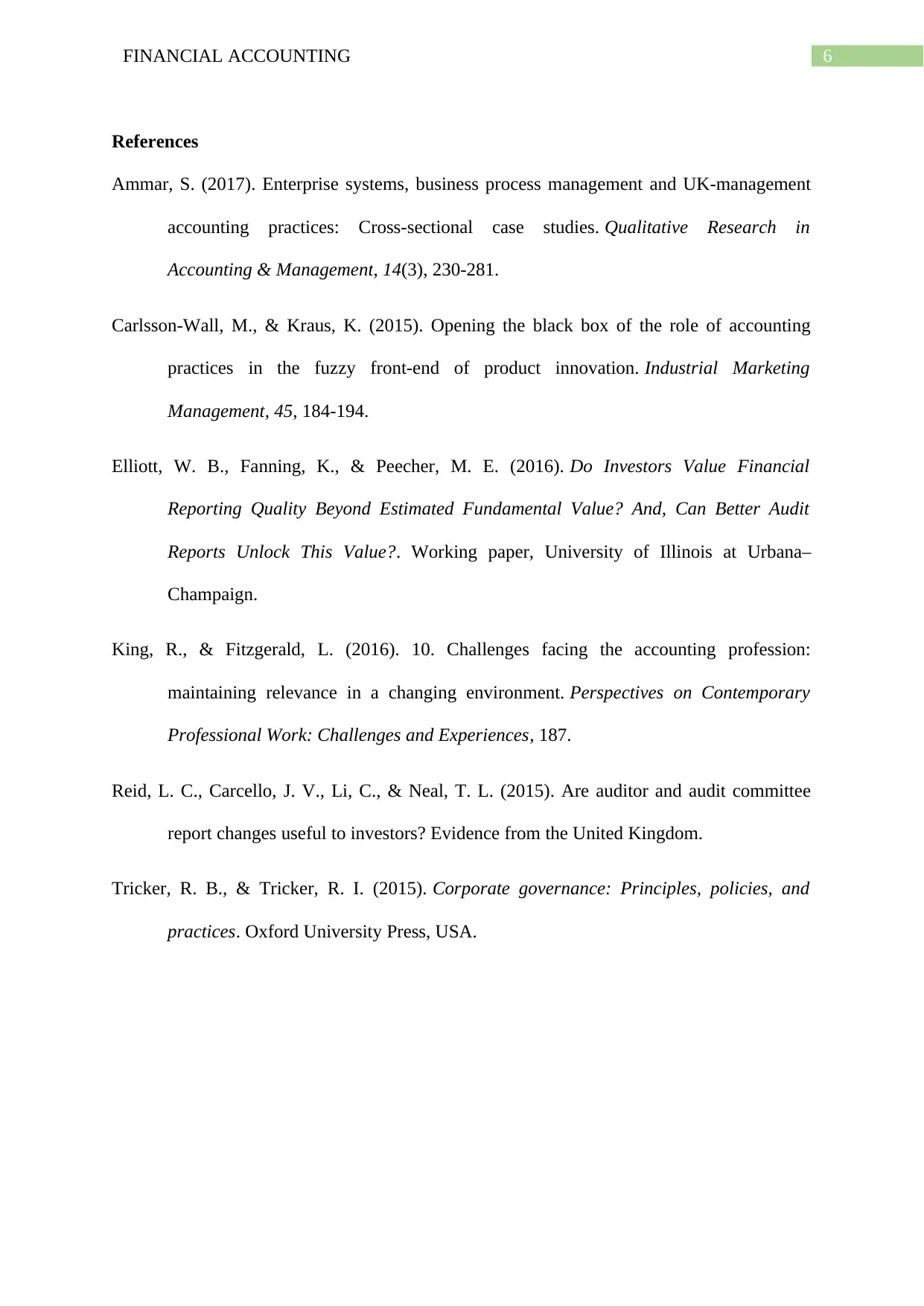
6FINANCIAL ACCOUNTING
References
Ammar, S. (2017). Enterprise systems, business process management and UK-management
accounting practices: Cross-sectional case studies. Qualitative Research in
Accounting & Management, 14(3), 230-281.
Carlsson-Wall, M., & Kraus, K. (2015). Opening the black box of the role of accounting
practices in the fuzzy front-end of product innovation. Industrial Marketing
Management, 45, 184-194.
Elliott, W. B., Fanning, K., & Peecher, M. E. (2016). Do Investors Value Financial
Reporting Quality Beyond Estimated Fundamental Value? And, Can Better Audit
Reports Unlock This Value?. Working paper, University of Illinois at Urbana–
Champaign.
King, R., & Fitzgerald, L. (2016). 10. Challenges facing the accounting profession:
maintaining relevance in a changing environment. Perspectives on Contemporary
Professional Work: Challenges and Experiences, 187.
Reid, L. C., Carcello, J. V., Li, C., & Neal, T. L. (2015). Are auditor and audit committee
report changes useful to investors? Evidence from the United Kingdom.
Tricker, R. B., & Tricker, R. I. (2015). Corporate governance: Principles, policies, and
practices. Oxford University Press, USA.
References
Ammar, S. (2017). Enterprise systems, business process management and UK-management
accounting practices: Cross-sectional case studies. Qualitative Research in
Accounting & Management, 14(3), 230-281.
Carlsson-Wall, M., & Kraus, K. (2015). Opening the black box of the role of accounting
practices in the fuzzy front-end of product innovation. Industrial Marketing
Management, 45, 184-194.
Elliott, W. B., Fanning, K., & Peecher, M. E. (2016). Do Investors Value Financial
Reporting Quality Beyond Estimated Fundamental Value? And, Can Better Audit
Reports Unlock This Value?. Working paper, University of Illinois at Urbana–
Champaign.
King, R., & Fitzgerald, L. (2016). 10. Challenges facing the accounting profession:
maintaining relevance in a changing environment. Perspectives on Contemporary
Professional Work: Challenges and Experiences, 187.
Reid, L. C., Carcello, J. V., Li, C., & Neal, T. L. (2015). Are auditor and audit committee
report changes useful to investors? Evidence from the United Kingdom.
Tricker, R. B., & Tricker, R. I. (2015). Corporate governance: Principles, policies, and
practices. Oxford University Press, USA.
1 out of 7
Related Documents
Your All-in-One AI-Powered Toolkit for Academic Success.
+13062052269
info@desklib.com
Available 24*7 on WhatsApp / Email
![[object Object]](/_next/static/media/star-bottom.7253800d.svg)
Unlock your academic potential
© 2024 | Zucol Services PVT LTD | All rights reserved.





